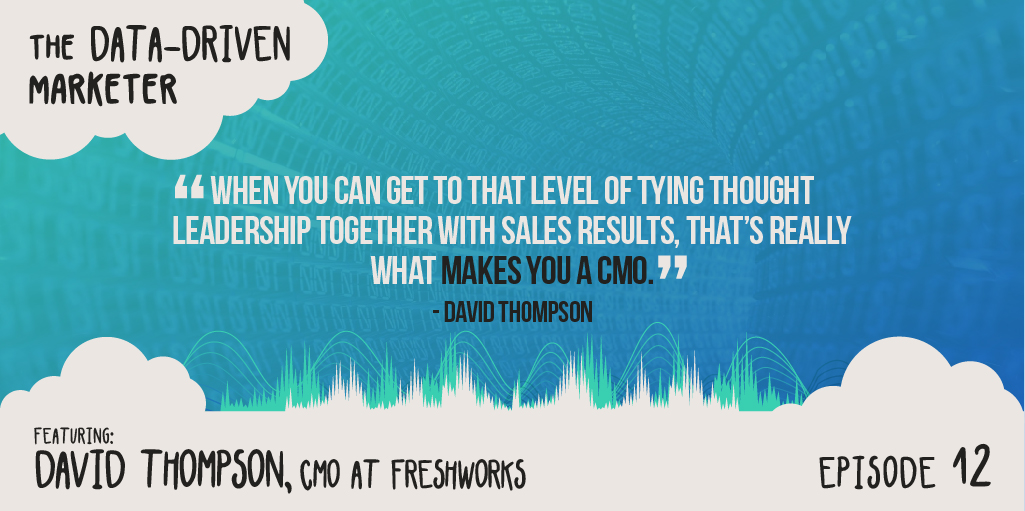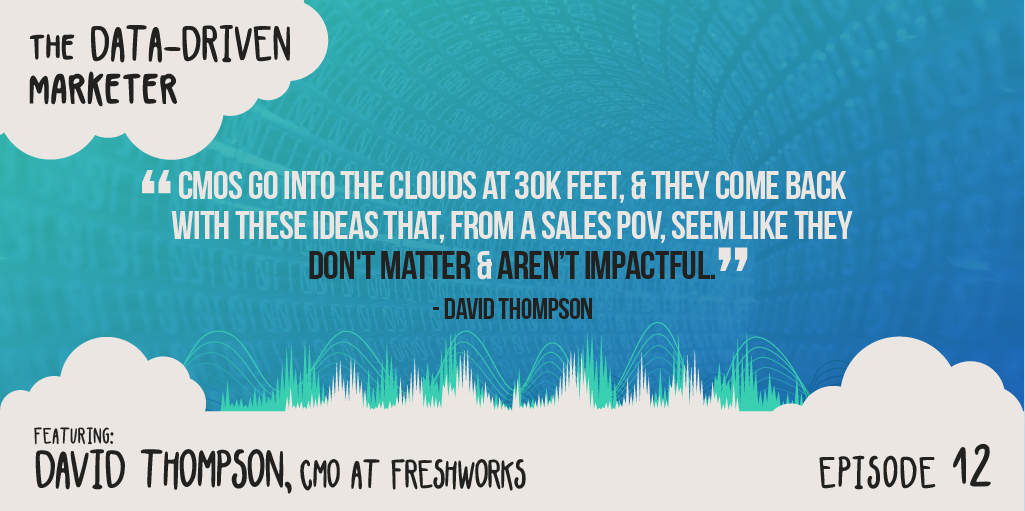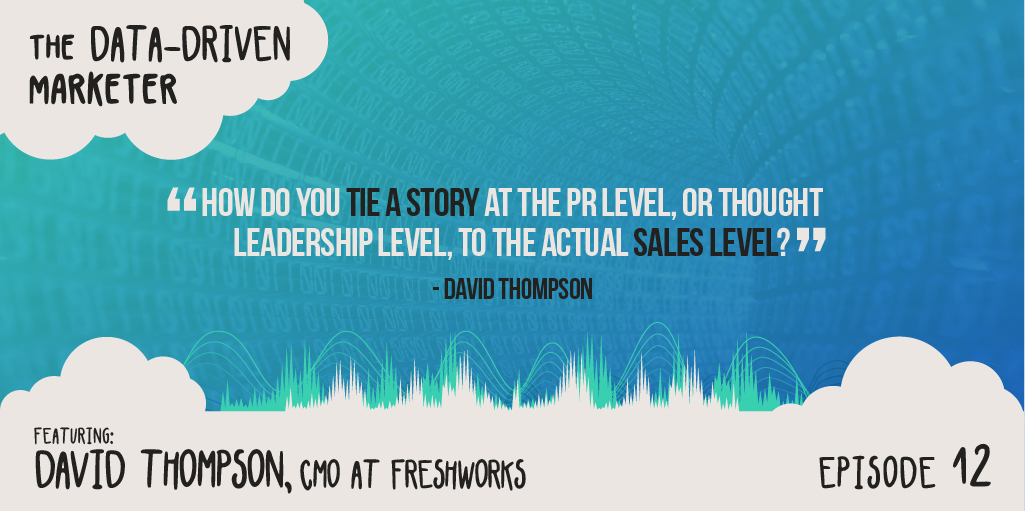
4 strategies to ensure data-driven thought leadership
Thought leadership strategies can drive incredible PR gains, increase website traffic, and put your company in the spotlight. Data can drive better decision-making and improved sales.
So how can you combine those to provide outstanding thought leadership, powered by the engine of data?
It’s called data-driven thought leadership.
To learn more, we asked the guy who knows how to use it. His name’s David Thompson and he’s the CMO at Freshworks. He joined us on the Data-Driven Marketer podcast to share 4 ways organizations can use data-driven thought leadership.
Here are the highlights from that interview:
CMOs: Make decisions that impact sales

Here’s a typical scenario: CMOs release some thought leadership or content on charitable giving, the cloud, company culture, etc. Here’s what the sales team (and many others in the company) are wondering:
“How does that thought leadership help us sell more?”
Salespeople, and, really, everyone, needs data.
You have to find a way to tie thought leadership into something that impacts sales.
That can look different for different organizations, and it requires creativity to look at a set of numbers, and then combine qualitative analysis to create thought leadership and strategies.
Here’s an example of data-driven thought leadership from when David worked with Google:
Before Freshworks, David had a variety of other SaaS experiences (in fact, he’s consulted with 25+ different Bay Area businesses on SaaS).
While working at another company as CMO, David was responsible for collaborating with Google to drive sales. The approach was data-driven: Google supplied analytics from real estate search queries that were combined into the company’s platform. The result was a powerful price predictor.
The collaboration with Google wasn’t just a PR booster. David’s company leveraged that collaboration to prove to real estate investors that their platform had powerful predictive capabilities. Revenue surged 15%.
Bring end-users into the decision-making
Want to make data-driven decisions? Go to the data.
It’s easy for upper management to make decisions at a 30k-foot level that sound really great on paper, but are confusing to employees on the front lines.
For example, David’s team at Freshworks recently released a survey called Voice in the Choice, and what they found is that management consistently makes software decisions that negatively impact those actually using the software.
Here’s a breakout of what they found:
- 96% of frontline workers had 0 involvement in the software management chose for them
- Over 50% said they’re less productive as a result of software chosen by management
- 24% said using certain software made them want to quit their jobs
- Up to 10 hours a week per user are wasted as a result of unwanted software
That means 500 million hours of productivity losses a year because of bad software, equating to $8 billion a year.
The solution’s simple: ask those who will be affected by your decisions.
As a result, David’s seen companies start involving their end-users at the beginning of the RFP process, into what are essentially competitive focus groups using competing software products. This gives the frontline employees a hand in the decision-making.
If you want to make a decision backed by data, you’ve got to use the data. For leaders, that means making sure that end-users affected by our decisions are brought into the decision-making process.
Don’t get ‘hyped’ (example: AI)

Upper management tends to get excited about the promise that they can pull a few levers and pop out some better numbers.
Nowhere is this more apparent than with AI.
AI is seductive, promising that if you purchase xyz software and embed it into your front lines, good things will happen.
Truth is, there’s often a much lower impact with end-users than predicted by the decision-makers.
Let’s get a little meta here, and use some data to illustrate the hype of AI:
The Voice in the Choice survey asked end-users about AI within their CRM systems:
Is AI helping you or not?
Guess what?
Only 12% of CRM users actually use AI.
Let’s stop right there; if 88% of users aren’t using a product that upper management thought was so important, then how effective can that product possibly be?
Here’s the take-away for us all: Don’t get hyped by shiny new toys.
Tie the data into the bigger story

How do you get to the CMO position, where you’re trusted by the CEO to make decisions that impact marketing and sales, and therefore the health of the entire organization?
You learn how to take data and tie it into a broader story.
It’s fairly straightforward, and commonplace for marketers, to use data to improve performance within a sales funnel by optimizing lead scoring. And most marketers can use data from focus groups to prove their product is better than a competitor’s.
However, to get to the CMO level, you have to be able to use data to tell an overarching story.
Remember back to the earlier example, when David’s company partnered with Google?
The reason that partnership was so successful was because David and his team were able to take advantage of the PR buzz created by the partnership, and tie it to data:
When the partnership was announced, CNBC and others caught wind. It made headlines. But headlines without numbers are just good headlines.
David’s team used that buzz and alliance to gain access to Google’s economist to help create the predictor I mentioned, called Auction.com Now Cast. Real estate businesses took note, selling more of their assets on Auction.com, increasing the volume of properties on their marketplace. That’s when sellers realized that Auction.com was going to be better at pricing their properties than anyone else.
That’s a small data piece: “We’re going to be better at setting the prices of your property.” But David was able to tie it into the overall big-picture of the alliance with Google.
Be sure to check out the audio link above for the rest of the story.
For more interviews from the Data-Driven Marketer podcast, check us out on Apple Podcasts, or at this link.
